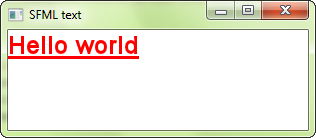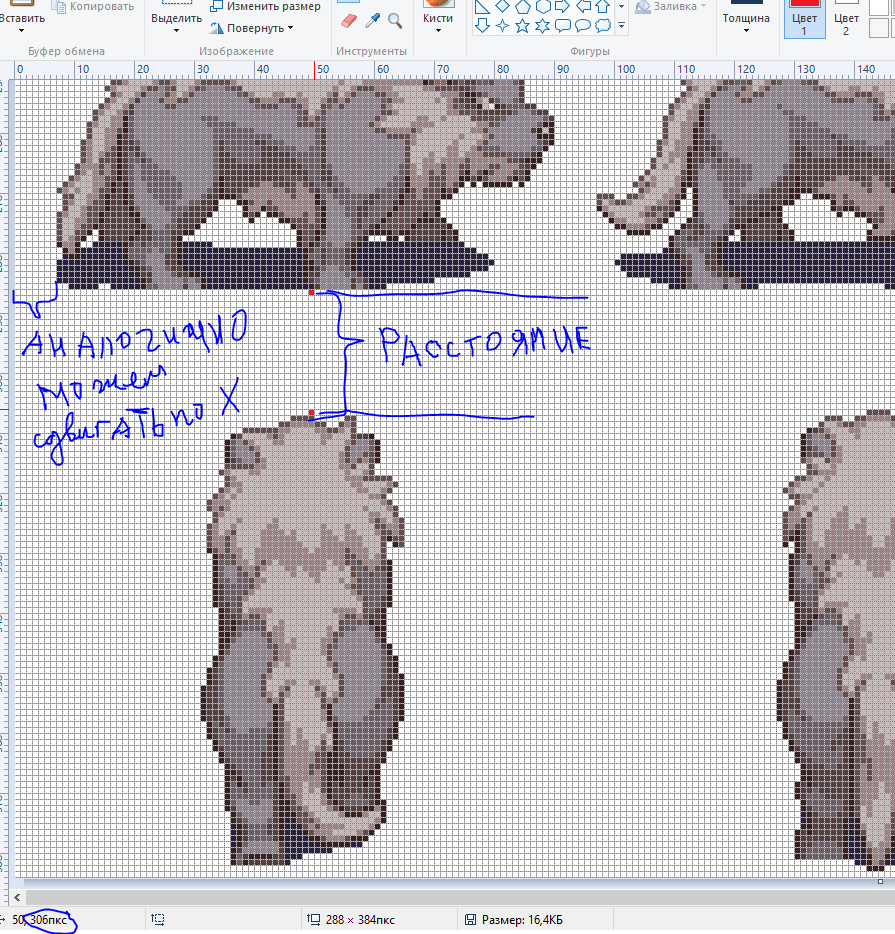Как выводить текст в sfml
Не выводится текст в sfml
SFML не могу нарисовать текст
Вот код класса: (возможно там всё криво, просто он с самого начала не работает, но постарался для.
Вывести текст используя SFML
Здравствуйте!! Подскажите пожалуйста как вывести текст в SFML. По примерам делала.
Решение
Тебе нужно загрузить шрифт желательно arial.TTF
это делается так ты его качаешь и закидываешь в папку с exe файлом и в папку с ресурсами
в коде пишешь
sf::Font font; //создаёшь переменную шрифт и называешь её font
if (!font.loadFromFile(«arial.TTF») )
<
//здесь если шрифт загрузился
//
>
sf::Text text;
text.setFont(font);// загрузка фона
text.setString(L»R управление»);// текст
text.setColor(sf::Color::White);//цвет
text.setCharacterSize(20);//размер
text.setPosition(1780, 0);//расположение
и внизу не забудь написать между window.clear(); и window.display();
команду window.draw(text);
Добавлено через 50 секунд
Тебе нужно загрузить шрифт желательно arial.TTF
это делается так ты его качаешь и закидываешь в папку с exe файлом и в папку с ресурсами
в коде пишешь
sf::Font font; //создаёшь переменную шрифт и называешь её font
if (!font.loadFromFile(«arial.TTF») )
<
//здесь если шрифт загрузился
//
>
sf::Text text;
text.setFont(font);// загрузка фона
text.setString(L»R управление»);// текст
text.setColor(sf::Color::White);//цвет
text.setCharacterSize(20);//размер
text.setPosition(1780, 0);//расположение
и внизу не забудь написать между window.clear(); и window.display();
команду window.draw(text);
Одно окно под SFML и текст
Добрый день уважаемые программисты. Только что столкнулся с одним нюансом. Он заключается в том.
SFML в C::B пытается что-то найти в D:\sfml-release\ которого нет
Добрый день, вторые сутки пытаюсь подключить SFML библиотеку к C::B. При подключении по мануалу с.

не могу собрать решение релиз версии, не пойму что я делаю не так постоянно выдает ошибку 1>LINK.
Текст и шрифты
Загрузка шрифта
Перед рисованием текста, вам нужно загрузить шрифт. Для работы со шрифтами используется специальный класс sf::Font. Он поддерживает три главных операции: загрузка шрифта, получение из него глифов (визуальных символов) и чтение его атрибутов.
Начнём с загрузки. Самый простой способ загрузить шрифт, это загрузить его из файла на диске, сделать это можно при помощи функции loadFromFile().
Обратите внимание на то, что SFML не станет автоматически загружать ваши системные шрифты, т.о. конструкция font.loadFromFile(«Courier New») работать не будет. Во-первых, потому, что SFML требует имена файлов, а не названия шрифтов, а во-вторых, потому, что SFML не имеет волшебного доступа к системной папке содержащей шрифты. И так, если вы хотите загрузить шрифт, то вам нужно иметь файл шрифта для вашей программы, точно так же, как и прочие ресурсы (картинки, музыку..).
Иногда функция loadFromFile() терпит неудачу по не очевидной причине. Сначала проверьте сообщение об ошибке выводимое в стандартный вывод (проверьте консоль). Если сообщение гласит unable to open file (не удалось открыть файл), убедитесь что рабочий каталог (это каталог относительно которого и будут интерпретироваться все пути к файлам) именно там, где вы предполагаете: когда вы запускаете приложение из проводника, рабочим каталогом является папка с приложением, но когда вы запускаете вашу программу через IDE (Visual Studio, Code :: Blocks, …), то рабочий каталог иногда устанавливается в папку с проектом, как правило это легко изменить в настройках проекта.
Вы также можете загрузить файл шрифта из памяти (loadFromMemory()), или из потока пользовательского ввода (LoadFromStream()).
SFML поддерживает наиболее распространенные форматы шрифтов. Полный список доступен в документации API.
Вот и все. Как только ваш шрифт загружен, вы можете начать рисовать текст.
Рисование текста
Для рисования вам нужно использовать класс sf::Text. Он очень прост в использовании:
Тексты могут быть трансформированы: они имеют позицию, ориентацию и масштаб. Функции применяемые при этом, точно такие же, как и для спрайтов sf::Sprite и для других объектов SFML, подробнее об этом рассказывается в уроке трансформация объектов.
Как избежать проблем с не ASCII символами?
Правильная обработка не ASCII символов (таких как русские, китайский, арабские..) может оказаться непростой задачей. Это требует от вас хороших знаний о различных видах кодировок участвующих в интерпретации и рисовании текста. Можно конечно помучится с этими кодировками, а можно поступить и проще: использовать расширенные строковые литералы.
Да-да, этот простой префикс «L» перед строкой сильно упрощает нам жизнь. Он, говорит компилятору о том, что используются расширенные строковые литералы. Довольно странно, но в стандарте C++ ничего несказанно об их размере (16 бит, 32 бита?) так же не сказано и о кодировке которую они используют (UTF-16 в UTF-32?). Однако мы знаем, что на большинстве платформ, если не на всех, они являются строками Unicode, и SFML умеет корректно их обрабатывать.
Обратите внимание, что стандарт C++11 поддерживает новые типы символов и префиксы для создания UTF-8, UTF-16 и UTF-32 строковых литералов, но SFML пока их не поддерживает.
Это может показаться очевидным, но вы также должны убедиться, что шрифт, который вы используете, содержит символы, которые вы хотите применить. Действительно, шрифты не определяют все возможные символы (их более 100000 в стандарте Unicode!), И арабский шрифт не будет в состоянии отображать текст на японском языке.
Собственный класс для работы с текстом
Если класс sf::Text вам кажется ограниченным в своих возможностях или вы хотите сделать что-нибудь с глифами перед их рисованием на экране, то класс sf::Font обеспечит вас всем необходимым.
Во-первых, вы можете получить текстуру, которая содержит все глифы определенного размера:
Заметьте, глифы добавляются в текстуру лишь по требованию. Шрифт может содержать так много символов (более 100000), что все они не могут быть сразу получены на этапе загрузки. Вместо этого они визуализируются на лету при вызове функции getGlyph() (см. ниже).
Что бы сделать что-то полезное с текстурой глифа, вы теперь должны получить координаты глифов которые в ней находятся:
Символ (character) — это UTF-32 код глифа который вы хотите получить. Кроме того, вы должны указать размер символа и спецификацию глифа (жирный(bold), обычный(regular)).
Структура sf::Glyph содержит три члена:
Наконец, вы можете получить некоторые другие метрики шрифта, такие как интервал между строками или кернинг (всегда для определенного размера символа):
Text and fonts
Loading a font
Before drawing any text, you need to have an available font, just like any other program that prints text. Fonts are encapsulated in the sf::Font class, which provides three main features: loading a font, getting glyphs (i.e. visual characters) from it, and reading its attributes. In a typical program, you’ll only have to make use of the first feature, loading the font, so let’s focus on that first.
The most common way of loading a font is from a file on disk, which is done with the loadFromFile function.
You can also load a font file from memory ( loadFromMemory ), or from a custom input stream ( loadFromStream ).
SFML supports most common font formats. The full list is available in the API documentation.
That’s all you need to do. Once your font is loaded, you can start drawing text.
Drawing text
To draw text, you will be using the sf::Text class. It’s very simple to use:
Text can also be transformed: They have a position, an orientation and a scale. The functions involved are the same as for the sf::Sprite class and other SFML entities. They are explained in the Transforming entities tutorial.
How to avoid problems with non-ASCII characters?
Handling non-ASCII characters (such as accented European, Arabic, or Chinese characters) correctly can be tricky. It requires a good understanding of the various encodings involved in the process of interpreting and drawing your text. To avoid having to bother with these encodings, there’s a simple solution: Use wide literal strings.
It is this simple «L» prefix in front of the string that makes it work by telling the compiler to produce a wide string. Wide strings are a strange beast in C++: the standard doesn’t say anything about their size (16-bit? 32-bit?), nor about the encoding that they use (UTF-16? UTF-32?). However we know that on most platforms, if not all, they’ll produce Unicode strings, and SFML knows how to handle them correctly.
Note that the C++11 standard supports new character types and prefixes to build UTF-8, UTF-16 and UTF-32 string literals, but SFML doesn’t support them yet.
It may seem obvious, but you also have to make sure that the font that you use contains the characters that you want to draw. Indeed, fonts don’t contain glyphs for all possible characters (there are more than 100000 in the Unicode standard!), and an Arabic font won’t be able to display Japanese text, for example.
Making your own text class
If sf::Text is too limited, or if you want to do something else with pre-rendered glyphs, sf::Font provides everything that you need.
You can retrieve the texture which contains all the pre-rendered glyphs of a certain size:
It is important to note that glyphs are added to the texture when they are requested. There are so many characters (remember, more than 100000) that they can’t all be generated when you load the font. Instead, they are rendered on the fly when you call the getGlyph function (see below).
To do something meaningful with the font texture, you must get the texture coordinates of glyphs that are contained in it:
character is the UTF-32 code of the character whose glyph that you want to get. You must also specify the character size, and whether you want the bold or the regular version of the glyph.
The sf::Glyph structure contains three members:
You can also get some of the font’s other metrics, such as the kerning between two characters or the line spacing (always for a certain character size):
Урок 12 SFML Работа с текстом
В этом уроке немного поработаем с текстом sfml. Текст встречается во многих играх, поэтому к нему мы еще будем возвращаться и в следующих уроках
Видеоверсия: http://www.youtube.com/watch?v=56rmko7OMtI
рассмотрим простой пример:
Добавьте побольше камней на карте, заменив символы ‘ ‘, на ‘s’
Добавим новую переменную playerScore в классе игрока:
Инициализируем её в конструкторе класса Игрока: ( туда же запихнул направление и скорость, поскольку был на форуме такой случай )
В функции взаимодействия с картой убираем телепортацию и пишем так:
В ф-ции int main() мы пишем:
Теперь нам нужно вывести текст в какую то позицию. Можно вывести его в позицию на карте, или же привязать к окну, чтобы текст бегал вместе с камерой и оставался на экране. Сделаем второй вариант:
Перед draw(p.sprite) напишем:
И теперь если запустим, увидим по центру надпись, а лев поверх неё. Поэтому – если текст будет по центру и вы хотите сделать его поверх льва – вы должны рисовать после draw(p.sprite).
Это может показаться не важным, но если у вас сложное меню или интерфейс программы – вы сразу вспомните эту простую вещь.
Чтобы передвинуть текст, например, левее и выше, следует написать:
Теперь давайте выведем количество собранных камней. Если мы напишем по привычке:
подключаем в main.cpp:
и тогда наша фиговина внизу примет такой вид:
нам на помощь пришла вспомогательная библиотека c++, которая позволяет работать со строками в потоке. Эта штука дает возможность сделать преобразование типов, см строку:
Теперь если мы запустим программу – камни можно будет собирать и это выводится на экран.
Этот метод вам нужен только если вы работаете с числовыми операциями (в нашем случае мы увеличивали переменную)
Когда проект ваш будет серьезен – для читаемости кода подобные вещи лучше выпиливать вне ф-ции main и в отдельные классы/файлы
В заключении хотелось бы сказать, что текст можно двигать, как и спрайт. у него так же есть метод ‘move’. помимо этого у него есть setPosition, вращение и многое другое. Этим инструментом можно пользоваться.
Как видим у нас есть один глюк, который при ходьбе, например вверх – съедает камень раньше, чем лев до него доходит. Почему? Потому что существует пустота на нашем тайле, которая воспринимается игрой как персонаж, поскольку входит в его ширину и высоту. Смотрите на картинке
, например последняя строка – видно, что вверху пустое пространство. (один тайл 96*96). Есть два выхода – грамотно и ровненько обрезать в редакторе эту пустую область и переделать немного код, обновив координаты вывода тайла. Или же в самом коде, в зависимости от направления движения персонажа, попробовать уменьшать w и h вывода тайла соответственно в зависимости от стороны движения.
На примере кнопки up покажу:
Documentation of SFML 2.5.1
Graphical text that can be drawn to a render target. More.
Public Types
Definition at line 48 of file Text.hpp.
Member Enumeration Documentation
◆ Style
Enumeration of the string drawing styles.




